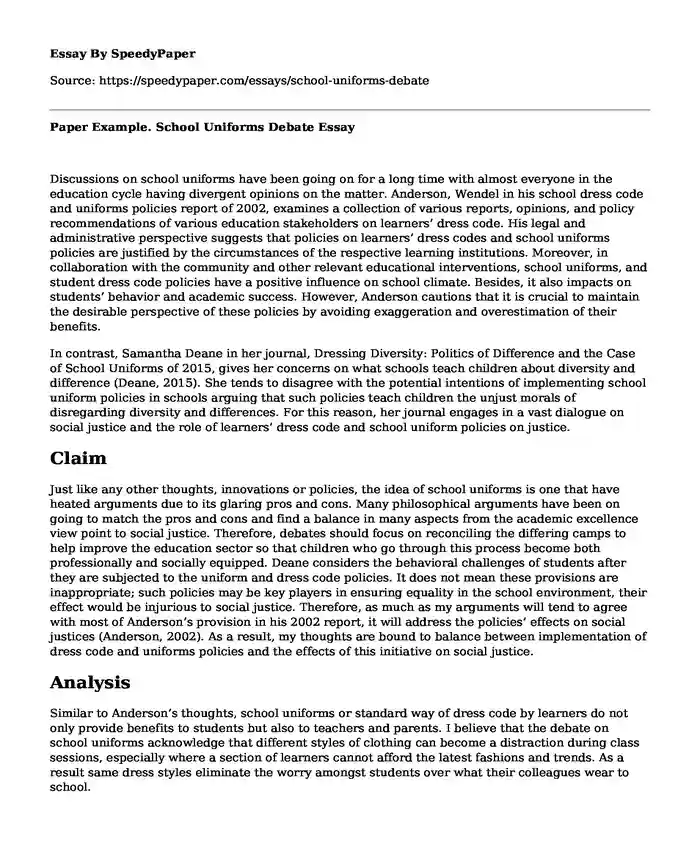
| Essay type: | Compare and contrast |
| Categories: | School Social justice Social issue |
| Pages: | 3 |
| Wordcount: | 792 words |
Discussions on school uniforms have been going on for a long time with almost everyone in the education cycle having divergent opinions on the matter. Anderson, Wendel in his school dress code and uniforms policies report of 2002, examines a collection of various reports, opinions, and policy recommendations of various education stakeholders on learners’ dress code. His legal and administrative perspective suggests that policies on learners’ dress codes and school uniforms policies are justified by the circumstances of the respective learning institutions. Moreover, in collaboration with the community and other relevant educational interventions, school uniforms, and student dress code policies have a positive influence on school climate. Besides, it also impacts on students’ behavior and academic success. However, Anderson cautions that it is crucial to maintain the desirable perspective of these policies by avoiding exaggeration and overestimation of their benefits.
In contrast, Samantha Deane in her journal, Dressing Diversity: Politics of Difference and the Case of School Uniforms of 2015, gives her concerns on what schools teach children about diversity and difference (Deane, 2015). She tends to disagree with the potential intentions of implementing school uniform policies in schools arguing that such policies teach children the unjust morals of disregarding diversity and differences. For this reason, her journal engages in a vast dialogue on social justice and the role of learners’ dress code and school uniform policies on justice.
Claim
Just like any other thoughts, innovations or policies, the idea of school uniforms is one that have heated arguments due to its glaring pros and cons. Many philosophical arguments have been on going to match the pros and cons and find a balance in many aspects from the academic excellence view point to social justice. Therefore, debates should focus on reconciling the differing camps to help improve the education sector so that children who go through this process become both professionally and socially equipped. Deane considers the behavioral challenges of students after they are subjected to the uniform and dress code policies. It does not mean these provisions are inappropriate; such policies may be key players in ensuring equality in the school environment, their effect would be injurious to social justice. Therefore, as much as my arguments will tend to agree with most of Anderson’s provision in his 2002 report, it will address the policies’ effects on social justices (Anderson, 2002). As a result, my thoughts are bound to balance between implementation of dress code and uniforms policies and the effects of this initiative on social justice.
Analysis
Similar to Anderson’s thoughts, school uniforms or standard way of dress code by learners do not only provide benefits to students but also to teachers and parents. I believe that the debate on school uniforms acknowledge that different styles of clothing can become a distraction during class sessions, especially where a section of learners cannot afford the latest fashions and trends. As a result same dress styles eliminate the worry amongst students over what their colleagues wear to school.
Additionally, uniforms also make dressing up for school easier for students and parents when they prepare learners for school every morning. Also, uniforms are relatively cheaper than the designer clothes and fashion that children would choose for their school attendance outfit. Therefore, parents tend to incur less expense on their children dress code for school. From the community context, it eases the identification and recognition of children as school goers so that the society knows how to treat them, when they need protection from harmful societal engagements.
However, the long term effect of instilling the uniform and dress code policies on learners unjust disregard on diversity and difference as argued by Deane. Such policies do not allow children to have the liberty of choosing what to wear hence losing their creativity capabilities. Besides, while proponents argue that uniforms discourage bullying and increase productivity, such sentiments do not have empirical proof. Therefore, as debates on school uniforms continue, I suggest the decision of learning institutions to impose uniform and dress code policies on their learners’ should be a mutual agreement between their stakeholders.
Conclusion
With the perpetual debates on the implementation of school uniforms and dress code policies, the glaring pros are cons do not seem to find a common ground for a solution. Moreover, the long-term effects on social justice in society and other broader challenges are coming up with research studies from various scholars. Deliberations should therefore focus on finding a point of agreement which is why I suggest the implementation of these policies should be under the mutual agreement of institutions’ stakeholders.
References
Anderson, W. (2002). School Dress Codes and Uniform Policies. Policy Report.Deane, S. (2015). Dressing Diversity: Politics of Difference and the Case of School Uniforms. Philosophical Studies in Education, 46, 111-120.
Cite this page
Paper Example. School Uniforms Debate. (2023, Oct 27). Retrieved from https://speedypaper.com/essays/school-uniforms-debate
Request Removal
If you are the original author of this essay and no longer wish to have it published on the SpeedyPaper website, please click below to request its removal:
- Check Out Leadership and Organizational Conflict Discussed in a Free Essay
- Free Essay: Poverty and Security in South Asia
- Essay Sample on Homelessness and Poverty
- My Career Goal. Free Essay Example
- Report on the Conflict Between the Public and Police Following the Assassination of George Floyd - Free Essay
- Special Topics in Criminal Justice. Free Essay
- Essay Example: Entrepreneurial Beginnings Discussion
Popular categories




